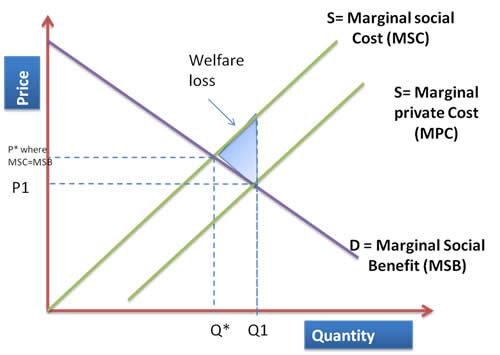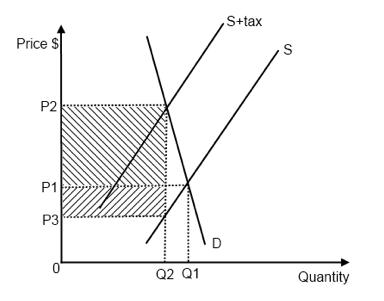Theme 1-Market failure & Government intervention
1/52
Earn XP
Description and Tags
Name | Mastery | Learn | Test | Matching | Spaced |
|---|
No study sessions yet.
53 Terms
What is the basic economic problem?
infinite wants,finite resources therefore choices must be made
what questions concerning allocation of resources arise from this problem?
What to produce
How to produce
For whom to produce
technical efficiency
concerned with maximising outputs for a given set of inputs
productive efficiency
concerns minimising costs for given outputs
Allocative efficiency
measures whether resources allocated to those goods and services demanded by consumers
How does markets allocate resources efficiently
prices send signals to producers and consumers about society’s needs and wants and the relative scarcity of inputs
three functions of the price mechanism in the efficient allocation of resources
Rationing
Signaling
Incentive
Best allocation of resources is achieved when…
benefits to consumers=costs of producers
Market failure
occurs when the price mechanism causes an inefficient allocation of resources,leading to a net welfare loss.Consequently,resources are not allocated to their best or optimum use.
Allocative inefficiency may occur when a good may be:
overproduced and over-consumed because the market price is too low
under-produced and under-consumed because the market price is too high
partial market failure
occurs when the market exists,but it produces either the wrong quantity of a product or at the wrong price,leading to overproduction or underproduction
complete market failure
occurs when the market simply does not exist,leading to no production of a good or service
Types of market failure
Externalities
Public goods
Information gaps
Externalities
where the markets fail to bring the best result for society as a whole.An externality is a cost or benefit that is imposed onto a third party that is not priced into the final cost or benefit of a good
for example- A factory that pollutes the environment creates cost to society,but those costs are not priced into the final good it produces
public goods
there are goods such as lighthouses that cannot be provided by a free market as there is no obvious way in which a private firm could charge all users or indeed would want to provide the goods at all as there is little to no profit incentive in their provision.’free rider problem’
information gaps
where buyers or sellers have imperfect information about a product. In order for markets to allocate resources effectively and efficiently,it is important that the economic agents have a good information about the markets in order to make rational decisions
Example of a market failure in real life
Financial crisis 2008:
excessive risks taken by too big to fail banks
assumed no macroeconomic consequences e.g externalities
Section 1: Externalities
costs or benefits that are external to an exchange.They are third party effects,ignored by the price mechanism
exists where the market fails to bring the best result for society as a whole
Private cost (PC)
the cost of an activity to an individual economic unit such as consumers or a firm
Social cost (SC)
cost of an activity not just to the individual economic unit that creates the cost,but to the rest of society as well.
Negative externality
occurs when SC>PC
positive externality
happens if the value or benefit to society (SOCIAL BENEFIT) exceeds the benefit to the private individual economic unit that created it (PRIVATE BENEFIT)
free market will not lead to optimumallocation of resources if..
the full cost or benefit is not reflected in the market due to externalities
why is there a makert failure if a producer does not pay the full cost of what is produced
too much of that good may be produced and there is a market failure because the free market lead to over-production of goods with negative externalities.
Third parties
individuals,organisations,property owner or resources that is indirectly affected
Negative production externalities
is said to esxist when a thrid party is adversely affected as a result of a firms production decisions.
e.g coal fired power station will incur private costs of raw materials ,wages etc but will also impose external costs on third parties such as the visual impact of an ugly building,poor air quality affecting the health of nearby residents etc.
diagrammatic (marginal) analysis of negative production externalities - 2 supply curves
S1 or Sfirm accounts only for the firms internal or private (financial) costs which is refers to as marginal private cost
S2(above S1) or Strue takes into account the additional costs to society which is referred to as marginal social cost
marginal private cost (MPC)
the cost to the firm of producing an additional unit of output
marginal social cost (MSC)
MPC+MEC(marginal external cost)
what happens to MEC-the cost to third parties of producing one more unit of output at higher levels of output?
it will be higher (e.g the impact on the environment of burning an extra litre of diesel in an already polluted area is greater than if that area were free from pollution) the msc curve will diverge from the mpc curve and the gap (MEC) will get bigger
negative externalities graph
positive consumption externalities
exists when the benefit to society of an economic transaction are greater than the individual consumer of the good or service,so there are additional benefits to third parties.
positive consumption ecternality benefits
private (PB)
external(EB)
social(SB)
private benefit
benefits to individual/firm directly involved in the transaction (e.g the higher future earnings potential as a result of higher education)
external benefits
benefits to third parties not direclty involved with the production/consumption decision (e.g the higher tax revenues collected from higher earning graduates and the lower crime rates too. )
social benefits
the total benefits to society of a particular decision, i.e private and external (so SB=PB+EB) if SB>PB then a positive consumption externality is said to exist
case study-vaccination
external benefits
reduced treatment cost for nhs
fewer days lost to sickness
higher tax revenues due to longer working life
herd immunity people who are unable to be vaccinated or dont respond to it face lower risk of contracting
diagramatic (marginal) analysis of positive consumption externalities 2 demand curves:
D1 or Dcons only accounts for the individuals assessment of private benefits which is more technically referred to as marginal private benefit
D2(above D1) or Dtrue which takes into account additional benefits to society which is referred to as marginal social benefit
marginal private benefit
the benefit to the individual of consuming an additional unit
marginal social benefit
MPB+MEB(marginal external benefits)
positive consumption externality graph
Indirect taxation
also known as an expenditure or sales tax is imposed on producers by the government so consumers pay indirectly
two types of indirect taxation
specific or unit tax
ad valorem tax
specific or unit tax
tax levied on volume e.g excise duties.The amount of tax levied does not change with the value of the goods nut with the amount or volume of the goods purchased e.g excise duties on alcohol,tobacco,petrol
ad valorem tax
a tax levied as a percentage of the value of the good.Most goods have a 20% VAT charge.NB some goods such as petrol carry both specific and ad valorem taxes
how does indirect tax effect externalities
it internalises the externality e.g raise the price ans reduce output of the good to achieve the social optimum by making the consumer and producer take account of the external costs and benefits through their pocket
the incidence of tax
refers to how the burden of tax is distributed between firms and consumers the incidence
arguement in favour of using indirect tax
internalises negative externalities ( polluter pays)
tax revenue from e.g tobacco sales could be hypothecated (ear marked or ring fenced) e.g school education programmes on health risk of smoking
can be targeted at a specific problem
essential goods and services could lower rates or be exempted
tax evasion on indirect tax harder than direct tax where individuals may self assess
arguements against using indirect tax
regressive-falls hardest on low income earners
loss of consumer surplus
if too high it makes the uk internationally uncompetitive e.g petrol/diesel
blunt instument e.g responsible drinkers as well as problem drinkers pay the same
ineffective in reducing goods that are highly inelastic PED e.g cigarettes and alcohol




